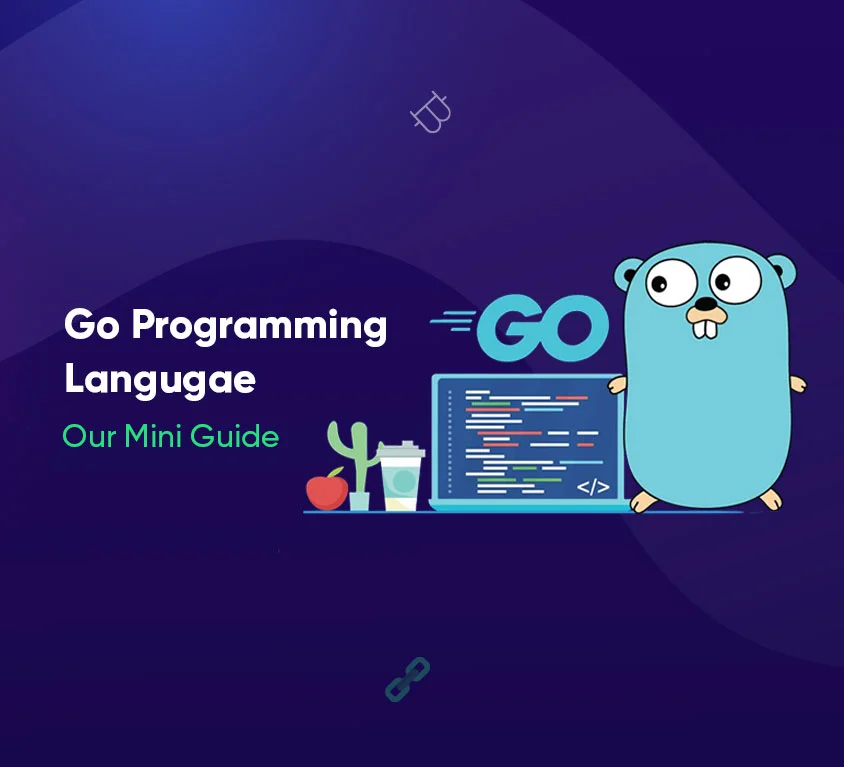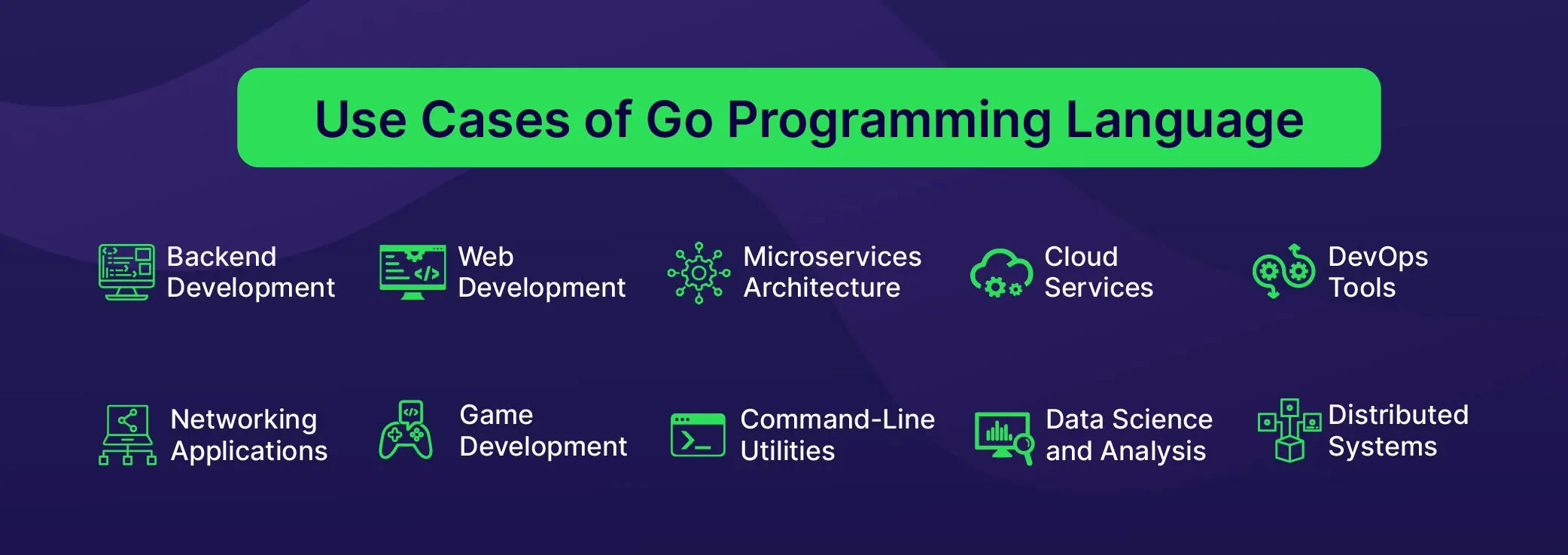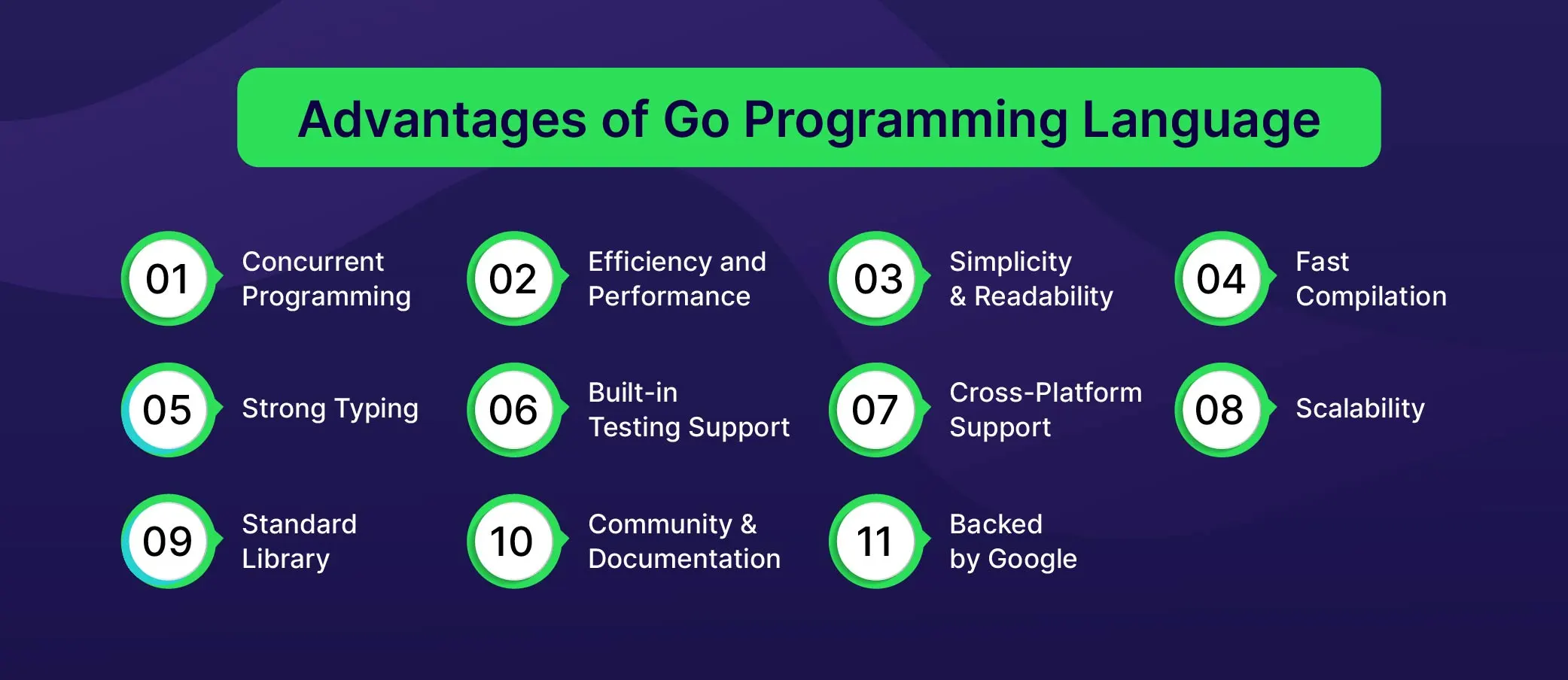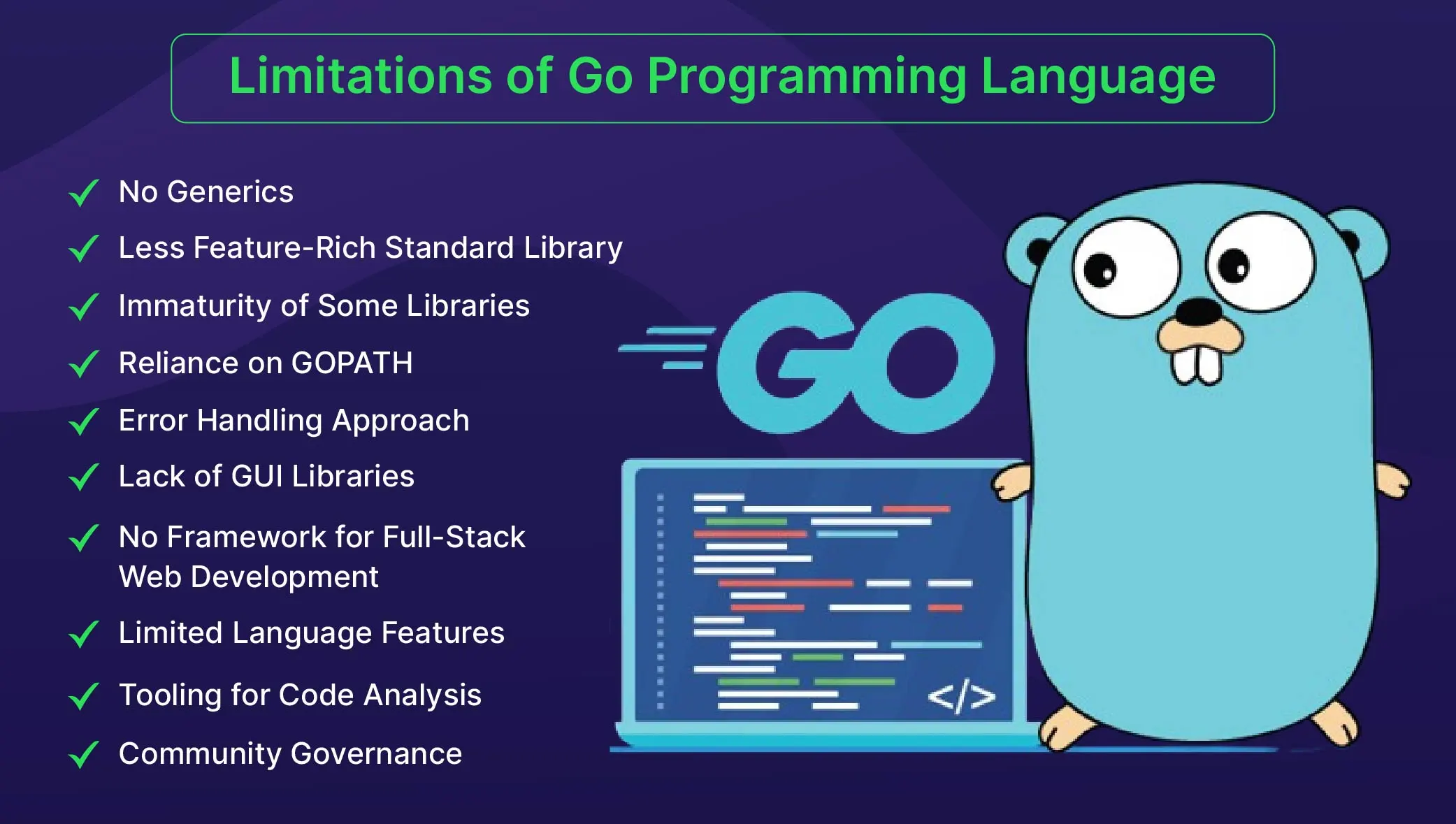
Introduction
Blockchain & Web3 Services Trusted By Leaders
- Develop innovative solutions using our state-of-the-art blockchain expertise.
- Achieve accelerated growth with robust & scalable Web3 consulting.
- Unlock 360-degree security with our top-rated blockchain development.
Go Programming Language: Our Mini Guide
Go, often referred to as Golang, is a versatile programming language. This is designed to support efficient system-level programming. It was developed by Ken Thompson, Rob Pike, and Robert Griesemer at Google in 2007. In addition, Golang boasts so many features such as built-in support for concurrent programming and more. In the vast landscape of the best blockchain programming languages, Solidity Java, Python, C++, Swift, SQL, and JavaScript often dominate discussions. However, emerging languages are gaining recognition, and Go is steadily becoming a favorite among developers. But why? In this blog, we will learn about C++ and Go programming languages and will provide insights into their use cases and considerations for developers. It is important to understand the characteristics and applications of these languages that can assist developers in making informed choices based on project requirements and team preferences.What is Go or Golang Programming Language?
Go or Golang distinguishes itself by its focus on simplicity, readability, and efficiency. It is designed to address the shortcomings of other languages, providing a clean and concise syntax. Developers are drawn to Golang for several reasons:- Go’s design prioritizes efficiency in both development and execution, making it suitable for building scalable and high-performance applications.
- The language’s simplicity enhances readability and reduces the cognitive load on developers, leading to faster development cycles.
- Go’s concurrency model, with goroutines and channels, simplifies the implementation of concurrent systems, a crucial aspect in modern software development.
- The Go community is active and supportive, contributing to a wealth of libraries, frameworks, and resources for developers.
- Go excels in building scalable applications, making it a popular choice for projects with growth potential.
History of Go Programming Language
In 2007, Google introduced Go, aiming to address shortcomings in existing languages. The vision was to create a language blending C++ efficiency, Python readability, and Java’s execution speed. The goal was to tackle complexities prevalent in contemporary languages amid evolving computer capabilities. After an intensive two-year development, Go was announced in 2009. It’s statically typed, compiled for efficiency, and features a garbage collector with native support for concurrent programming. Striking a balance between simplicity and functionality was pivotal for Go’s accessibility and capability. Go gained global traction for its simplicity and efficiency, extending beyond Google. Its concurrent programming capabilities made it ideal for web servers and data pipelines. Notably, Go played a crucial role in Docker’s 2011 development, showcasing its prowess in automation and application management.What does the Golang Programming Language do?
The Go Programming Language is a meticulously crafted, statically typed, and compiled language aimed at addressing prevalent challenges in programming. Its primary focus is to provide developers with a powerful yet straightforward tool for building efficient and scalable software. Here are some key aspects of what the Go Programming Language does: Go achieves efficiency through features like static typing, machine code compilation, and an automatic garbage collector for effective memory management. Emphasizing simplicity and readability, Golang promotes a clean syntax, steering clear of unnecessary complexities. This commitment facilitates a straightforward and efficient development process. Scalability is a key strength, with its concurrency model and efficient garbage collection making it suitable for large-scale systems and distributed computing.
Support for cross-compilation enables the creation of binaries for various operating systems and architectures from a single codebase, promoting cross-platform compatibility. Equipped with essential tools like Go build, Go run, and Go test, Go streamlines development, while the formatting tool (gofmt) enforces a consistent coding style for improved readability.
Go’s vibrant community actively contributes to its growth, supported by a rich ecosystem of libraries and frameworks that empower developers to leverage existing solutions for diverse tasks. In web development, Go’s standard library simplifies handling HTTP requests and responses, with frameworks like Gin and Echo further enhancing its capabilities. Overall, the Go Programming Language stands out as an efficient, scalable, and developer-friendly tool, backed by a growing community and a diverse ecosystem.
Emphasizing simplicity and readability, Golang promotes a clean syntax, steering clear of unnecessary complexities. This commitment facilitates a straightforward and efficient development process. Scalability is a key strength, with its concurrency model and efficient garbage collection making it suitable for large-scale systems and distributed computing.
Support for cross-compilation enables the creation of binaries for various operating systems and architectures from a single codebase, promoting cross-platform compatibility. Equipped with essential tools like Go build, Go run, and Go test, Go streamlines development, while the formatting tool (gofmt) enforces a consistent coding style for improved readability.
Go’s vibrant community actively contributes to its growth, supported by a rich ecosystem of libraries and frameworks that empower developers to leverage existing solutions for diverse tasks. In web development, Go’s standard library simplifies handling HTTP requests and responses, with frameworks like Gin and Echo further enhancing its capabilities. Overall, the Go Programming Language stands out as an efficient, scalable, and developer-friendly tool, backed by a growing community and a diverse ecosystem.
What is Go used for?
Golang is used for a variety of purposes due to its design principles and features. Here are some common use cases:
1. Backend Development
Golang is widely used for building scalable and efficient backend services and APIs. Its concurrency model and performance make it suitable for handling numerous simultaneous requests in web servers.
2. Web Development
Golang is employed in web development to create web applications and services. Its standard library includes features for handling HTTP requests and responses, making it suitable for building robust web applications.
3. Microservices Architecture
The simplicity, efficiency, and built-in support for concurrency make Golang a popular choice for developing microservices. Its lightweight nature allows for the creation of modular and independently deployable services.
4. Cloud Services
Golang is utilized for developing cloud-based applications and services. Its efficiency and scalability are advantageous in handling the dynamic and distributed nature of cloud environments.
5. DevOps Tools
Golang is often chosen for building DevOps tools and infrastructure components. Popular tools like Docker and Kubernetes are written in Go due to their performance, ease of deployment, and efficient resource utilization.
6. Networking Applications
Golang is suitable for developing networking applications, including network servers and utilities. Its support for concurrent programming and efficient handling of network-related tasks makes it a solid choice.
7. Distributed Systems
Golang is well-suited for blockchain development and applications. Its concurrency primitives, such as goroutines and channels, simplify the development of parallel and distributed systems.
8. Command-Line Utilities
Golang is used for creating command-line tools and utilities. Its simplicity, fast compilation, and cross-platform support make it an excellent choice for developing efficient and portable command-line applications.
9. Data Science and Analysis
While not as prevalent as in languages like Python, Golang is gaining traction in data science and analysis tasks. Its performance and ease of use make it suitable for certain data processing and analysis applications.
10. Game Development
Golang is occasionally employed in game development, particularly for building server-side components of online games. Its efficiency and concurrent programming capabilities can contribute to responsive and scalable game servers. BloxBytes also provides gamefi services, in case you already have a game but don’t know anything about the ecosystem, our consultants are 24/7 ready to assist you.
Advantages of Go Programming Language
The Go Programming Language, commonly known as Golang, offers several advantages that contribute to its popularity among developers. Here are some key advantages of using Go:
1. Concurrent Programming
Go excels in concurrent programming with its lightweight goroutines and channels. This enables developers to easily implement concurrent and parallel processing, making it well-suited for scalable and efficient systems.
2. Efficiency and Performance
Golang is a compiled language that produces native machine code. This, coupled with its garbage collection mechanism, contributes to its efficiency and performance. Go programs typically exhibit fast execution speeds, making them suitable for applications requiring high performance.
3. Simplicity and Readability
Go is designed with simplicity in mind. Its clean and minimalistic syntax promotes readability, reducing the cognitive load on developers. This simplicity contributes to faster development cycles and easier maintenance of codebases.
4. Fast Compilation
Go’s compiler is known for its speed, allowing developers to quickly build and deploy applications. This rapid compilation is particularly beneficial for iterative development and quick turnaround times.
5. Strong Typing
Go is statically typed, which means that type checking is done at compile-time. This helps catch errors early in the development process, leading to more robust and reliable code.
6. Built-in Testing Support
Go has a built-in testing framework that simplifies the process of writing and executing tests. This encourages the practice of writing testable code, facilitating the development of reliable and maintainable software.
7. Cross-Platform Support
Go supports cross-compilation, allowing developers to build binaries for different operating systems and architectures from a single codebase. This cross-platform compatibility makes it easier to deploy applications on various environments.
8. Scalability
Golang is designed to handle scalability challenges effectively. Its concurrency model, along with features like goroutines, makes it well-suited for building scalable systems and handling numerous concurrent connections.
9. Standard Library
Go comes with a rich standard library that includes essential packages for tasks such as networking, file I/O, and cryptography. This reduces the reliance on third-party libraries for common functionalities.
10. Community and Documentation
Go has a supportive and active community. The language’s official documentation is comprehensive and well-maintained, providing valuable resources for both beginners and experienced developers.
11. Backed by Google
The fact that Go was developed by Google lends it credibility and resources. Google’s involvement ensures ongoing support, updates, and enhancements to the language.
Limitations of Go Programming Language
While the Go Programming Language (Go or Golang) has gained widespread popularity, it is not without its limitations. Here are some notable limitations of Go:
1. No Generics
One significant limitation is the absence of generics in Go. This can lead to code duplication and less flexibility in designing data structures and algorithms. However, it’s worth noting that there were ongoing discussions within the Go community about introducing generics in future versions.
2. Less Feature-Rich Standard Library
Although Go’s standard library is robust, it might lack some of the features found in other languages. This can sometimes necessitate the use of third-party libraries to fill in functionality gaps.
3. Immaturity of Some Libraries
While Go has a growing ecosystem of libraries, some areas may still lack mature and feature-rich libraries compared to more established languages. This could impact the development of certain types of applications.
4. Reliance on GOPATH
Go traditionally relies on the GOPATH environment variable, which determines the workspace for Go projects. This has been a source of contention, and while module support has been introduced to mitigate this, it’s still a consideration, especially for developers accustomed to other project structures.
5. Error Handling Approach
Go’s error-handling approach, which involves returning errors explicitly, can be seen as both an advantage and a limitation. Some developers may find it verbose compared to languages with exceptions.
6. Lack of GUI Libraries
As of my knowledge cutoff in 2022, Go’s support for graphical user interfaces (GUIs) is limited compared to some other languages. Developing desktop applications with rich graphical interfaces may require additional effort.
7. No Framework for Full-Stack Web Development
Go lacks a full-stack web development framework similar to those available in languages like Solidity programming language (Hardhat Network, Ganache, and Anvil) Python (Django, Flask), or JavaScript (Node.js with Express). While there are web frameworks for Go, they are not as comprehensive.
8. Limited Language Features
Go intentionally keeps its feature set limited to maintain simplicity. While this simplicity is an advantage, it can be a limitation for developers who are accustomed to more feature-rich languages.
9. Tooling for Code Analysis
While Go has strong tooling for formatting and linting, more advanced code analysis tools (such as those provided by IDEs for languages like Java or C#) may be less mature for Go.
10. Community Governance
The Go project is primarily governed by Google. While Google’s involvement has been beneficial, some developers might prefer a more community-driven governance model.
Go vs C++: Comparing Golang with C++ programming language
Aspect |
Go |
C++ |
|---|---|---|
Concurrency and Parallelism |
Built-in support with goroutines and channels | Supports multithreading but lacks built-in concurrency |
Memory Management |
Automatic garbage collection | Manual memory management with more control |
Compilation and Execution Speed |
Fast compilation, balanced runtime performance | Fine-grained control over optimization, high-performance options |
Syntax and Readability |
Emphasizes simplicity and readability | More complex syntax, especially with advanced features |
Ecosystem and Libraries |
Growing ecosystem, simplicity-focused | Mature ecosystem, vast libraries covering many domains |
Error Handling |
Explicit error handling with return values | Uses exceptions for error handling |
Community and Adoption |
Gaining popularity in cloud and backend | Long-established, used in various domains |
Portability |
Built-in cross-compilation support | Portable with potential platform-specific adjustments |
Learning Curve |
Easier to learn and become productive quickly | Steeper learning curve due to extensive features |
Use Cases |
Backend services, cloud solutions, concurrent applications | Systems programming, game development, embedded systems |
Which programming language is better?
The determination of whether Go or C++ is better depends on the specific needs and goals of the development project. Each language has its strengths and weaknesses, and the choice should align with the priorities of the Blockchain development team and the requirements of the application. Go is particularly well-suited for projects that prioritize simplicity, concurrency, and scalability. It excels in handling concurrent tasks efficiently, has automatic garbage collection for streamlined memory management, and features fast compilation with a focus on runtime performance balance. Go’s clean and concise syntax, growing ecosystem, and popularity in cloud services and backend development make it an excellent choice for concurrent and scalable blockchain applications. C++, on the other hand, offers fine-grained control over optimization during compilation, making it suitable for performance-critical applications, systems programming, game development, and embedded systems. Its mature ecosystem, extensive libraries, and widespread adoption across various domains contribute to its versatility. However, C++ does come with a steeper learning curve due to its complex syntax and feature set. Ultimately, the “better” choice depends on the specific goals of the project and the preferences and expertise of the Blockchain development company. If simplicity, concurrency, and scalability are top priorities, Go may be the better fit. If fine-grained control, performance optimization, and a mature ecosystem are important, C++ might be the preferred choice. Consideration of factors such as project requirements, team expertise, and long-term maintainability should guide the decision-making process.Hire a Go Programmer from BloxBytes
Seeking a seasoned Go programmer to elevate your project to new heights? Bloxbytes brings you top-notch Go programming expertise tailored to meet your unique needs. Hiring our Skilled Go Programmer, you will get:- Seasoned professionals with a deep understanding of Go’s unique features, from concurrency and performance optimization to effective error handling.
- Go programmer who is adept at leveraging Go’s capabilities to deliver fast, scalable, and reliable software solutions.
- Golang strength lies in its concurrency model, and our programmers excel at crafting concurrent applications that meet the demands of modern, distributed systems.
- Whether your project requires cross-platform compatibility or specific optimizations, our Go programmers have the skills to deliver seamless solutions across different environments.
- From backend development and microservices to scalable web applications, our Go programmers have a diverse skill set to tackle a range of projects, ensuring versatility in meeting your requirements.